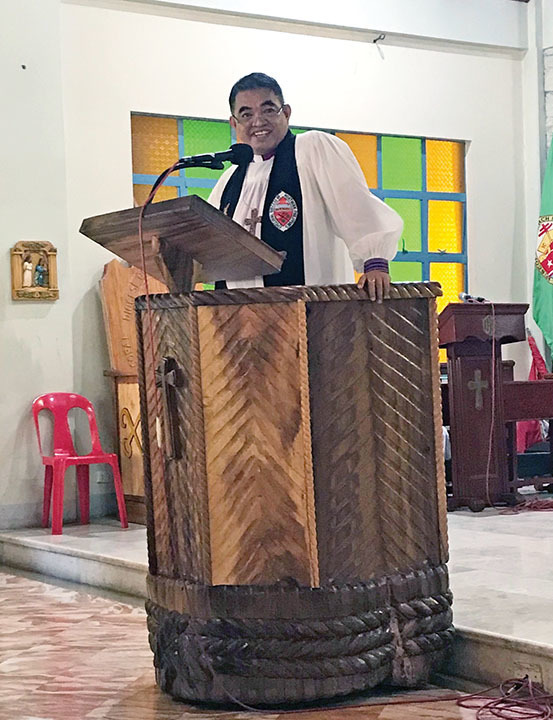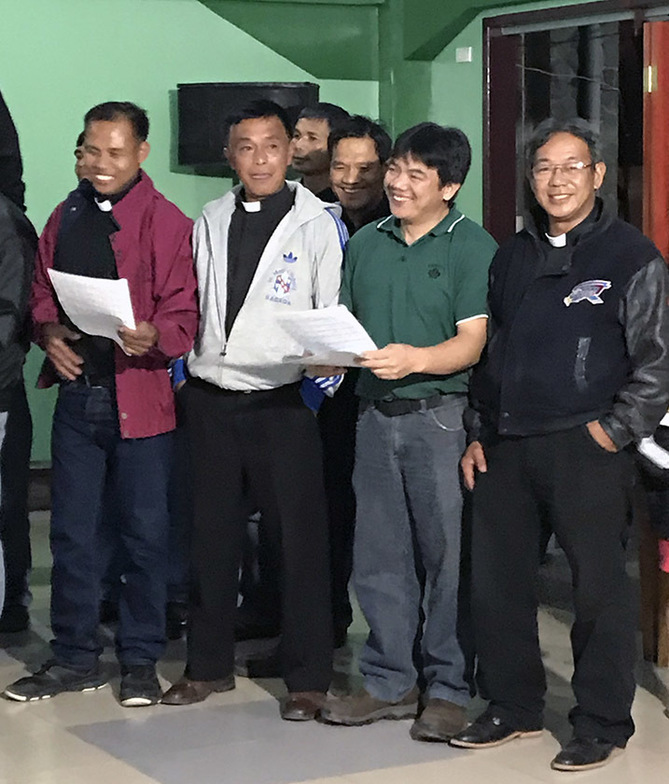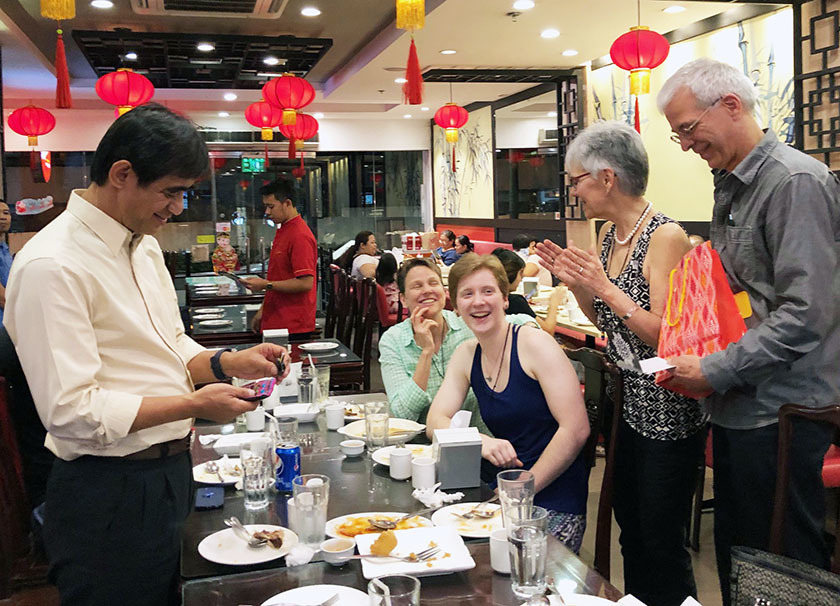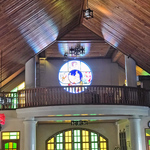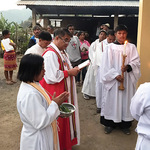The Halsema Highway snakes north and east among the spiny ridges of the Cordillera (mountain range) from Baguio City to Bontoc. As the road coils and recoils from one blind curve to another, our white van overtakes tour buses, trucks, and jeepneys. Lloyd, our driver, maneuvers with confident familiarity on this road, his friend and constant challenger, navigating fallen rocks and sleeping dogs, and finessing the frequent lane closures on this writhing, narrow, shoulderless roadway.
Our objective is to reach All Saints Cathedral in Bontoc on Tuesday, February 19 in time to join the 2:30pm opening procession for the 48th Diocesan Convention of the Episcopal Diocese of Northern Philippines (EDNP). For more than three years, this has been the companion diocese to our diocese, the diocese of New Westminster. EDNP is a remote but vital center of Anglican presence in the Philippines. As our van approaches the cathedral, right on time, we pass under a banner that spans the main street of Bontoc: “Welcome Archbishop Melissa Skelton and Party.” Feels like we made the local news!
We pass through the gate of the cathedral compound, a city block near the center of downtown, and the van comes to a very welcome stop. Immediately we are met by Bishop Brent Alawas and a posse of priests; each of us is given a convention name tag by the priest of our partner parish—a first meeting for most of us. For the upcoming Sunday Eucharist, we (Archbishop Melissa and Party) will fan out to these same parishes to offer a homily or presentation. It will be a wonderful opportunity to gatherfirsthand impressions of our partner parishes; likewise, it will fall to us to give a first impression to those assembled faithful, a prospect that we have pondered in the past days and weeks with some mixture of excitement and worry.
Our “Party,” I should by now explain, is a cross-section of our own outpost of the Anglican Church, selected for the trip to plant this project of companionship more securely in the soil of both dioceses. The team comprises three newly ordained clergy, a youthful lay person, a Filipino priest, an ordained member of the synod staff, and me, a deacon and returning visitor. Along with the Archbishop herself. The roster is as follows: transitional deacons the Rev. Tasha Carrothers (Missioner for Congregational Development) and the. Rev. Cameron Gutjar (third-year seminarian at Huron College), the (recently priested) Rev. Vivian Seegers (Assistant Curate at St. Clement, Lynn Valley and ordained leader of the Urban Aboriginal Ministries), Jade Martin-Seedhouse (member of Diocesan Council), the Rev. Arvin Amayag (priest of St. Mary the Virgin, Sapperton), the Rev. Tellison Glover (Director of Mission and Ministry Development), and yours truly (deacon at St. Michael’s Multicultural Church, Vancouver). Plus, of course, in the Party but not of the Party, Her Grace, the Most Reverend Melissa Skelton.
EDNP Convention
Some 350 delegates, grouped into a half dozen deaneries, process through several blocks of the city, a seemingly strong statement about the position of the Church in this community. Our place in the parade is toward the back just ahead of the marching clergy, all in albs and heartily singing hymns. We join in the singing as we pass through the streets to occasional applause from bystanders. Five hymns later, we finish at the main doors of the cathedral, which we enter, passing under still more welcoming banners.
Once the convention is under way, Bishop Brent addresses the assembly, recognizing each member of our group, and then introducing the theme of the convention: Intentional Discipleship. This theme will be developed in several ways, including a pair of bible study sessions, one of them to be led by Archbishop Skelton on the third day of convention. Spoiler alert: That presentation, which explored disciple making on the road to Emmaus, was a significant success. As a consequence, a reprise was requested in Manila on the last day of our trip, for the students and faculty at St. Andrew’s Seminary.
The Episcopal Church in the Philippines (ECP) has shown a history of growth over the last century, from one diocese (1937) to three (1971) to currently seven dioceses. The leadership points with pride to the evidence of this growth: many new and expanded church buildings, numbers of congregations that have emerged as fully self-supporting parishes. At the national level, this ambitious growth allowed the Philippine church to end its financial dependence on The Episcopal Church USA in 2003, three years ahead of plan.
In the last decade, a couple of programs have contributed to that sustained movement from dependence to mutual interdependence. One of these, “Receivers to Givers,” reflects a philosophy of financial support whereby a grant to a parish is first used constructively, after which that parish generates funds to pass the grant along to another parish, effectively repaying the money forward. A related program that assists in this process is called ABCD, Asset-Based Congregational Development. This program leverages the collective entrepreneurship of the parishes to seed a variety of productive activities, from hog-raising to earth block manufacture.
Describing ABCD in a 2013 blog, Mark Harris (former Canon of ECP) praised it as “a fine example of melding development concerns with traditional values of stewardship and congregational health…. In looking again at the assets a congregation has, not only the funds, property, community standing, etc, but talents and time of its members, congregations often find new courage for congregational life and action.”
In one instance, a parish rebuilt its church using compressed earth blocks—large building blocks which offer several advantages over concrete blocks. Having acquired a machine for manufacturing the compressed earth blocks via a grant, members of the congregation (chiefly women) became proficient in its use. They supplied several thousand blocks for their own project, and then went on to produce blocks for sale, amassing funds that they could, in turn, pay forward. Receivers to givers, with a boost from ABCD.
Sagada
The mountain town of Sagada, 45 minutes from Bontoc, is a destination for many tourists, both foreign and Filipino. The attractions are many—its natural beauty, set in a forest of tall pines; local artisans, who produce woven goods and pottery; and its cultural treasures, to include the limestone caves whose openings have been traditional burial sites for above ground coffins.
Our visit to Sagada was primarily focused on its development as a missionary hub. Sagada is home to the oldest church building in Mountain Province, the Episcopal Church of St. Mary the Virgin (rebuilt after being partially destroyed by allied bombing in World War II). Alongside the church is St. Theodore of Tarsus Hospital, and down the road is St. Mary’s School. Each has developed from the efforts of American missionaries of the early 20th century, who recognized the value of providing not only church buildings, but schools and clinics as well. One might think of it as a holistic community development approach, one that succeeded in establishing a strong and still growing presence for the Anglican Church in the northern Philippines.
US missionaries chose the mountainous north as a primary locus for their evangelism because it was a region that had historically refused the efforts of the Roman Catholic Church during the time of Spanish domination. Under the leadership of Charles Henry Brent (a Canadian who was ordained in the Episcopal Church in upstate New York at a time when clergy posts in Southern Ontario were scarce), the first Missionary Bishop of the Episcopal Church in the Philippines, the emphasis was on introducing the faith via a social gospel to non-Christian populations in areas such as the Cordillero and Mindanao (primarily Muslim). He was famously opposed to proselytizing Roman Catholics, seeing little value in “setting up one altar against another.”
More than avoiding confrontation, however, the legacy (and current influence) of the EDNP has been to defuse existing strife. Again and again, the stories related to us by Bishop Brent and others provide a portrait of church leaders past and present who placed themselves in perilous positions to mediate conflicts, some of them bloody. From the clashes between the national government and the rebellious People’s Army, to the strife that has erupted between tribes in recent decades (and for centuries), and even to municipal struggles over the use of valuable public space for a multi-level parking lot, church leaders have been resolute in their advocacy for peace, unity, and the embrace of traditional culture.
Butbut
Perhaps the greatest contrast that we encountered between our North American circumstances and those of our hosts was our homestay in the remote mountain village of Butbut. Our arrival was planned for 1pm, but after a lengthy lunch break, our little convoy of three road-hardy vehicles reached Butbut at 2:30, after a steep 90-minute ascent on rough, partially paved roads. Roughly 40 people stood gathered at the village boundary to greet us. They had been waiting, they said, since 1pm, ready with cups of water and a song of welcome (written for the occasion). Our accepting the water “put us under their protection,” we learned. It was about as alien a place as I could imagine, and yet it felt like a homecoming.
We were paired up with host families and settled into the best rooms and best beds the village had to offer. Toilets were floor level, flushed from a bucket. We bathed with cold water. Much of the cooking occurred over a wood fire. Furnishings were sparse. Outside and among all the other houses, livestock roamed freely: chickens, pigs, dogs. Yes, dogs are livestock. Our host’s family dog faithfully trailed after her when she led us through the village to the church. “Does the dog have a name?” I asked. “No.” One doesn’t get too attached. Beyond the village were the rice fields, terraced into the mountainsides. It was on that crop, planted twice a year, that the people subsisted. “What do you do for work?” I asked a shy young man who was nonetheless eager to practice speaking English. “I grow rice,” he said. “I am a farmer. We are all farmers.”
I could go on at length about our time in Butbut—the packed and energetic worship, the exorcism of a malevolent spirit that lurked behind the church, the dinner of cooked snails. But for me, one moment from the evening’s entertainment speaks for the encounter. In the series of songs, tributes, inspirational speeches, and traditional dance, an elder was brought forward. As he began to recite, a doorway fell open into an ancestral past. In the staccato cadences of his chanting, in his gestures, and in the flashing of his glance from face to face, one felt oneself in the presence of an ancient invocation—of greeting, of blessing, perhaps even of warning. Vivian Seegers also commented on that moment with fascination and reverence. It was a strand of unbroken tradition, revealed to us, entrusted to us.
Parish visits
Another highlight of the trip was our dispersal late Saturday into a handful of outlying areas, in preparation for our participation in Sunday services at our partner parishes. Participation ranged from preaching (for most of us) to presenting a profile of our home church and its activities (Jade’s particular task) to celebrating the mass (Fr. Arvin, who accompanied the Rev. Seegers). In my case, participation involved traveling with Melissa to the town of Tadian, home to St. Michael and All Angels (partner to my home parish of St. Michael’s Vancouver). From there I was shuttled on Sunday morning to St Philip’s, a small preaching station of St. Michael’s, perched on the next ridge in the village of Tue.
Accompanying me was itinerant priest Lawig Ngaya-an, who would introduce me to the congregation and celebrate the Eucharist. Together we would enact the Seventh Sunday after the Epiphany, much of it in a language (Kankanae) that I did not comprehend. My well-rehearsed homily seemed to find its way into the assembly. And afterward we stood out in front of the church, between the palm-draped pillars, under the banner the welcomed me by name. We joined in a meal of mint tea and rice with coconut milk. Before the church were twelve stones arranged in a semicircle around one large stone. “This represents the Last Supper,” Fr. Lawig told me. Once again I felt myself a world away, and yet home.
Homeward, Onward
Our extrication from Mountain Province felt sudden but not swift. After a lavish breakfast in the residence of Bishop Alawas and his gracious and accomplished wife Shirley, we began what turned into a 15-hour descent to Manila. Our route took us back through Baguio and then on into the lowlands, joining a throng of vehicles returning from a holiday weekend. February 25, as fate would have it, marks the anniversary of the People Power Revolution, which is celebrated as an official holiday each year since the overthrow of President Ferdinand Marcos in 1986. Suffice it to say that the additional holiday travelers added 4 or 5 hours to our drive time, most of it spent at a near standstill as we wound our way down out of the Cordillera, staggering bleary eyed into the futuristic lobby of the Novitel Manila at 2:30am.
The last full day was spent debriefing as a group, shopping, swimming, and then dining in a nearby Chinese restaurant as guests of the ECP Provincial Secretary and National Development Officer, Floyd Lawlet and his wife, Marcie. Attorney Floyd is widely acknowledged as a strategist and national leader in the transformative growth of the Philippine Church, and we were honored to join him and his wife, a professor of biology at Trinity University.
The following morning found us packed, checked out, and transported to St. Andrew’s Seminary for our last official act. Archbishop Skelton repeated the bible study on Intentional Discipleship to a gathering of 70 or 80 students and faculty assembled in a large room that was both nave and lecture hall. Above our heads, suspended from the ceiling, was a fishing boat with its nets draped on either side, ready for a catch. On the wall behind the altar was a large carved crucifix, with the figure of Jesus in traditional costume of the mountain tribes. Such a blending of the sea and the mountains; the familiar Christian images along with the assertion of a vigorous and abiding indigenous identity. Our past and our present. Our future.
IMAGES
Please browse through the more than 60 photos uploaded to go with this report. Although the first photo is of the author at his parish visit to St. Philip's a preaching station (church plant) of St. Michael's the rest roughly follow the itinerary outlined in the piece. Photos were taken by and supplied to diocesan communications by Eric Stroo, Vivian Seegers, Melissa Skelton, Jade Martin-Seedhouse and Tellison Glover.












